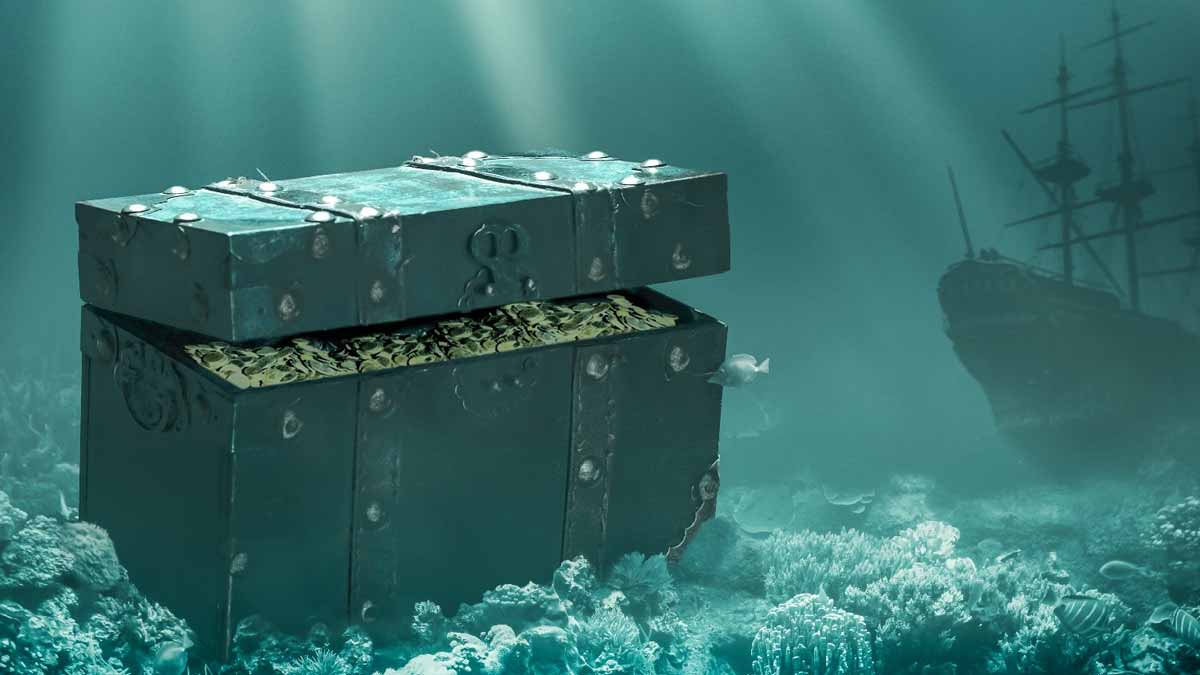A glint flared beneath gentle waves, and a routine swim turned electric. One coin surfaced, then a story rushed in, carried by sand and seagrass. Clues piled up fast, yet questions ran faster. Evidence hints at cargo, trade, and risk taken long ago, while a Hidden Shipwreck now hangs over everything—close enough to imagine, distant enough to chase.
From a Glint to a Roman Hoard
A lone sparkle shook free from a seagrass meadow off Sardinia, near Arzachena. The diver followed it into a sandy clearing, where metal flashed again and again. Each handful brought more pieces to light, as currents eased, grass buffered the site, and the seabed gave up its grip.
Soon, tens of thousands of coins lay in view. They are bronze and copper follis minted in Rome in the fourth century, dated to about 324–340 AD. Their patina looks steady, and their edges hold detail. The ministry calls their state of preservation “excellent” and “rare,” which fits what careful handling shows.
Weight alone suggests staggering volume. Officials estimate at least 30,000 pieces and possibly as many as 50,000. They rank this as one of the largest ancient coin finds in decades. That density, along with uniform dating, reads like cargo, and it also whispers of a nearby Hidden Shipwreck waiting in the same sands.
Clues Pointing to a Hidden Shipwreck Beneath the Seabed
Coins rarely gather by accident in one tight patch. Cargo spills when a hold breaks, or a hull fails under stress. Seagrass meadows trap heavy items, so coins settle, then sand blankets them. The site’s natural layout reduces surge, which limits scouring and helps fragile traces last.
No hull has appeared yet, although hope remains strong. Underwater topography here can preserve timbers and fittings. As surveys expand, divers will widen the grid, log anomalies, and map layers. Patience matters, because shallow storm tracks, seasonal turbidity, and marine growth can hide clear shapes until conditions align.
Every small find sharpens the map. Spacings between clusters suggest original containers. Edges reveal how sediment moved. Even subtle color shifts in sand mark oxygen levels and decay. When plotted together, these small signals can point to buried structure, so the likely wreck stays within reach as checks continue.
How the Site Was Secured and Studied
The diver called authorities at once. An art protection squad arrived, then the culture ministry’s undersea archaeology team joined. Firefighter divers supported access and safety, while border police divers guarded the perimeter. Roles stayed clear, so documentation stayed clean, because chain of custody protects both science and heritage.
Teams set a simple grid and worked layer by layer. Gentle water jets freed sand without stripping surfaces. Coins went into mesh bags, then labeled trays. Each lift tied to a sector and depth, so context survived the move. That way, laboratory work can read position, not just metal and wear.
Near the hoard, divers met “walls” of narrow-necked, two-handled jars—amphorae stacked or aligned as cargo. Their pattern strengthens the cargo reading and narrows search lines. Amphorae beside currency make trade feel close and real, as if ledger and load sat together. It also renews the case for a Hidden Shipwreck nearby.
What the Coins Reveal About a Hidden Shipwreck and Ancient Trade
These coins are follis pieces in bronze and copper. They were first Roman and later circulated under the Byzantine Empire. Mint marks trace back to Rome. Dates near 324–340 AD place them in the late imperial shift, when reforms reshaped money and routes pulsed with state and private freight.
Their condition looks unusually strong for open water. Quick burial in sand within seagrass limits oxygen and abrasion, so detail survives. That matches official notes on an “excellent and rare” state. It also implies a sudden event, because slow losses spread out, while rapid loss compacts goods and seals them fast.
Volume matters as much as date. The weight points to 30,000–50,000 items. That scale rarely fits pockets or casual drops. It fits chests, sacks, and locked stowage. Numismatic study will read legends and dies, which can trace workshops, track supply, and test whether one shipment carried fresh coin direct from Rome.
Next Steps: Science, Protection, and Public Value
Conservators will bathe the coins to pull out salts, then clean them by hand. Imaging will log obverse, reverse, and edges, so scholars can compare strikes and wear. Catalogs will grow, item by item, as storage slows corrosion. Public display will follow, so the find can teach and inspire safely.
Survey crews will sweep the area with side-scan sonar and magnetometers. ROVs and cameras will watch anything odd as divers confirm. If timbers or fittings appear, they will stabilize them in place when possible. If not, targeted lifts will follow strict rules, because even fragments can frame a Hidden Shipwreck in full.
Officials stress duty as well as wonder. Director Luigi La Rocca notes how rich and important the seabed remains, since people and goods crossed here early and often. The message travels well : report finds, protect context, and let careful work tell the route, the cargo, and the risks sailors faced.
A rare windfall that could rewrite a stretch of seafloor history
This hoard turns a quiet clearing into a live archive. The coins speak to routes, reform, and risk, while amphorae echo the ship that carried them. Divers, scientists, and guardians now share one goal: follow the evidence, piece by piece, until the Hidden Shipwreck either appears—or proves how close it came.
